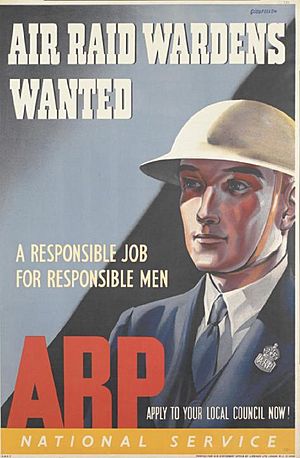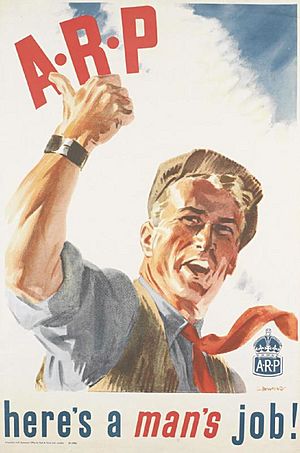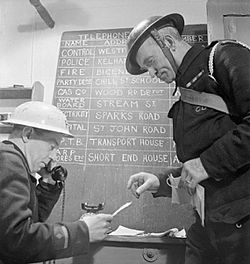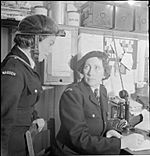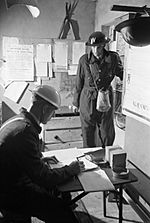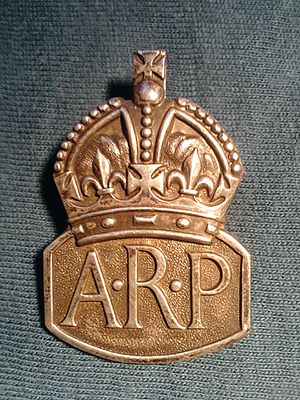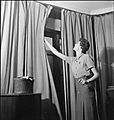Air Raid Precautions facts for kids
Air Raid Precautions (ARP) was a group of organisations and rules in the United Kingdom. Their main job was to protect regular people from the dangers of air raids, especially during World War Two. The government started thinking about air raid safety in the 1920s and 1930s. The Raid Wardens' Service began in 1937 to report on bombing events. Each local town council had to set up its own ARP teams. These teams included wardens, messengers, ambulance drivers, rescue workers, and people who worked with the police and fire brigades.
From September 1, 1939, ARP wardens made sure people followed the "blackout" rules. This meant all homes, shops, and factories had to cover their windows with heavy curtains or shutters. This stopped light from escaping. If lights were visible, enemy bombers could use them to find their targets.
When enemy bombing became much worse during the Blitz, the ARP services were very important. They reported and dealt with bombing incidents. They also managed the air raid sirens and guided people to safe shelters. Women helped a lot in ARP services through the Women's Voluntary Service.
The Auxiliary Fire Service started in 1938 to help local fire services. Later, in 1941, all these fire services joined together to form the National Fire Service.
In 1941, the ARP officially changed its name to the Civil Defence Service. This new name showed that they now did many more jobs. During the war, almost 7,000 Civil Defence workers died. About 1.5 million men and women served in this organisation during World War Two. At the peak of the Blitz, over 127,000 people worked full-time. By the end of 1943, this number dropped to 70,000. The Civil Defence Service stopped its work on May 2, 1945, near the end of the war in Europe.
Between 1949 and 1968, many of the jobs of the Civil Defence Service were brought back. This happened through a new group called the Civil Defence Corps.
Contents
Why ARP Started
During the First World War, Britain was bombed by Zeppelin airships and Gotha planes. People thought that in any future war, large-scale bombing of cities would happen. In 1924, a group called the Committee of Imperial Defence set up a smaller committee. This group looked at ways to protect people from air attacks. This new committee was called Air Raid Precautions. It was led by Sir John Anderson.
For the next ten years, this committee studied new air weapons. They also looked at how these weapons might affect people. The use of gas attacks in the First World War was a big concern. So, protecting people with gas masks became a main idea. Nearly 40 million gas masks would be needed for everyone. Other ideas included building air raid shelters, moving people to safer places, and blackout rules. These were all called "passive air defence."
As Adolf Hitler and Nazi Germany started to build up their army in the 1930s, another committee was formed. This was the Air Raid Precautions (ARP) Department, created in March 1935. This department took over from the earlier groups. It was in charge of Britain's plans for passive air defence.
In April 1937, the Air Raid Wardens' Service was created. They hoped to get about 800,000 volunteers. By mid-1938, about 200,000 people had joined. After the Munich Crisis in September 1938, another 500,000 people signed up. After the bombing of Guernica, Gaumont-British started showing news films about air-raid safety in cinemas. Wardens gave advice to the public. They also reported bombs and other events. The Women's Voluntary Service joined them in May 1938. On January 1, 1938, the Air Raid Precautions Act became law. This law made all local councils create their own ARP services. Air raid shelters started to be given out in 1938.
With war looking very likely in 1939, the Home Office gave out many leaflets. These leaflets told people how to protect themselves from the coming air war.
What ARP Wardens Did
The ARP services had several special groups:
Wardens
ARP wardens made sure the blackout was followed. They sounded air raid sirens and guided people safely into public air raid shelters. They also gave out and checked gas masks. Wardens helped move people away from unexploded bombs. They rescued people from bombed buildings when they could. They found temporary homes for those whose houses were bombed. They reported incidents and fires to their control centre. They also called for other services when needed.
Report and Control
This was the main office that received information from wardens and messengers. They managed sending out the right services for each incident.
Messengers
These were often Boy Scouts or Boys' Brigade members, usually aged 14 to 18. They would carry spoken or written messages from wardens to the control centre. Bombing sometimes cut telephone lines. So, messengers were very important for giving the ARP services a full picture of what was happening.
First Aid Parties
These teams were trained to give first aid to people hurt in bombing incidents.
Ambulance Drivers
Volunteer drivers took injured people from bombings to first aid posts or hospitals. There were also stretcher teams who carried the injured to these posts.
Rescue Services
The rescue services worked to get dead and injured people out of bombed buildings.
Gas Decontamination
These were specialists who dealt with and cleaned up areas affected by chemical weapons.
Fire Guards
After the huge damage from the bombing of the City of London in late December 1940, the Fire Watcher scheme started in January 1941. All buildings in certain areas had to have someone watching them 24 hours a day. If a fire started, these fire watchers could call rescue services. They also made sure rescuers could get into the building to deal with the fire.
During World War Two
Local councils were in charge of setting up all the ARP services in their areas. Usually, a warden was at least 30 years old. But men and women of all ages became wardens. Sometimes, even teenagers served as wardens if needed. Both men and women could join the ARP. However, only men could work in the gas contamination teams (for chemical bombs), and in heavy and light rescue and demolition services.
A chief warden led a local area's warden service. Area wardens reported to the chief warden. In cities, the goal was to have one warden for every 500 people. This number grew later. Wardens reported from their own posts, each with a post warden. Post wardens received messages from local wardens. They then sent these messages to the main Report and Control headquarters.
ARP wardens first worked from temporary posts in homes, shops, and offices. Later, special buildings were built for them, often at road junctions. In cities, a warden post covered a small area. In the countryside, areas were larger. There were about five wardens for every 4,000-5,000 people. In London, there were about ten posts per square mile. Each post had three to six wardens. They knew their local area well. They knew where shelters were, where utilities (water, gas, electricity) were, what was inside buildings (important for fire services), and who lived in their area.
ARP wardens also patrolled the streets during the blackout. They made sure no light was showing. If they saw a light, they would shout "Put that light out!" They could report people who kept breaking the rules to the local police.
For seven months after the war started in September 1939, there was a quiet period called the Phoney War. During this time, ARP wardens mostly gave advice. They handed out gas masks and air raid shelters. These included the outdoor Anderson and indoor Morrison shelter. They also made sure the blackout rules were followed.
The Blitz
The ARP services became extremely important during the Blitz of 1940–41. ARP control centres would sound the air raid sirens. Wardens would guide people into shelters. Then, they would watch for bombs falling in their area. This was very dangerous work during air raids.
When wardens found a bombed area, they would call for emergency services. They gave first aid to people with minor injuries. They also dealt with small fires, like putting sand on incendiary devices (bombs designed to start fires). Other ARP groups included first-aid teams, light and heavy rescue teams, stretcher teams, and messenger boys and girls. These messengers rode bicycles between incidents, carrying messages from wardens.
Other duties included helping to control areas damaged by bombs. They also helped people whose homes were bombed. They had to keep emergencies under control until official rescue services arrived.
From September 1, 1939, a small number of ARP wardens worked full-time and were paid. Men received £3 and women £2. But most were part-time volunteers. They did their ARP duties in addition to their regular jobs. Part-time wardens were supposed to work about three nights a week. But this increased a lot when bombing was heaviest. One in six wardens was a woman. Many of the men had fought in World War I.
Uniforms
At the start of the war, ARP wardens did not have a full uniform. They wore their own clothes. They wore helmets, arm bands, and badges on their civilian clothes. In October 1939, they were given 'bluette' overalls. These had a red on black 'ARP' badge.
From the start of the ARP until 1939, the badges were made by the Royal Mint. They were made of solid sterling silver. Men's badges had a crescent shape for buttonholes. Women's badges were like a pin brooch. From 1940 onwards, the badges were made from a cheaper metal.
From May 1941, full-time and regular part-time wardens received dark blue battledress and a beret. Women were given a dark blue tunic with four pockets and a skirt.
Helmets
ARP service members wore Mk. II British helmets. These helmets were often not made as strong as those given to soldiers. This was to save money. These helmets had less protection against bullets. They had small holes drilled in the rim to show they were not for front-line fighting. The helmet would have a letter or letters on it. This helped others quickly know what job the person did at an incident.
- W for wardens (some warden/fire guards had W/FG). A white helmet with black bands showed rank within the warden service.
- R for rescue services (later HR for heavy rescue and LR for light rescue were used).
- FAP for first aid parties.
- SP for stretcher parties (to carry injured people from incidents).
- A for ambulance drivers.
- M for messenger/runner.
How Many People Served

When the war began, more than 1.5 million people were involved in the different ARP services. There were about 1.4 million ARP wardens in Britain during the war.
The number of full-time ARP staff was highest in December 1940, with over 131,000 people. Nearly 20,000 of these were women. By 1944, the threat from enemy bombing was less. So, the total full-time ARP staff dropped to about 67,000. About 10,000 of these were women. In 1944, nearly 800,000 people were volunteers. About 180,000 of these volunteers were women.
Civil Defence Regions
Mainland Britain was split into eleven Civil Defence regions. Each region had a main office that managed the services there.
- Region 1 – Northern – Newcastle
- Region 2 – North Eastern – Leeds
- Region 3 – North Midland – Nottingham
- Region 4 – Eastern – Cambridge
- Region 5 – London
- Region 6 – Southern – Reading
- Region 7 – South Western – Bristol
- Region 8 – Wales – Cardiff
- Region 9 - Midland – Birmingham
- Region 10 – North Western – Manchester
- Region 11 – Scotland – Glasgow
- Region 12 – Northern Ireland – Belfast
Medals for Bravery
Many wardens did much more than their duty required. If you look at medal records in the London Gazette, you can see this. The first ARP warden to receive the George Cross was Thomas Alderson. He earned his award for saving civilian lives in Bridlington in 1940.
Gallery of ARP photographs
See also
- Air raid siren
- Air raid shelter
- Auxiliary Fire Service
- Civil Defence Service
- Strategic bombing during World War II
- The Blitz


